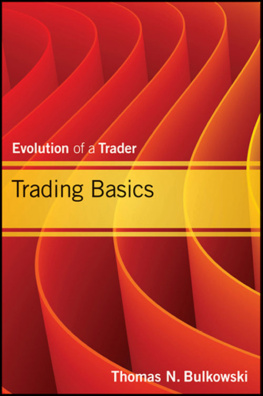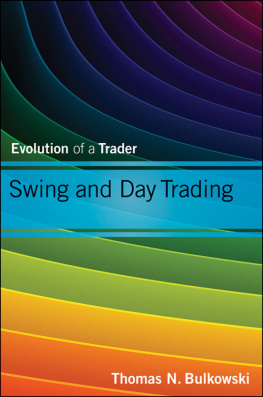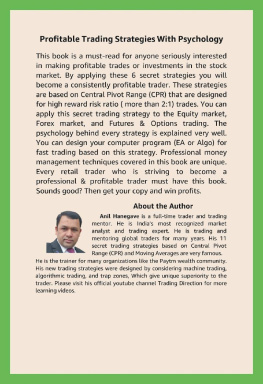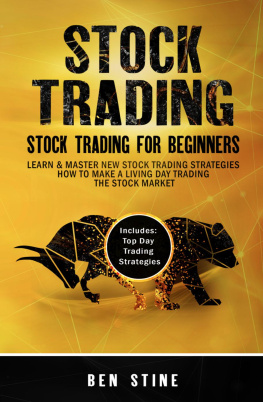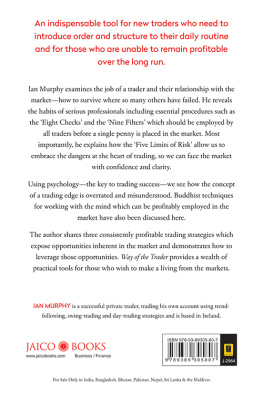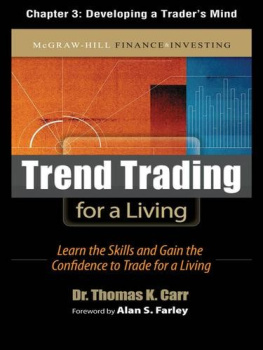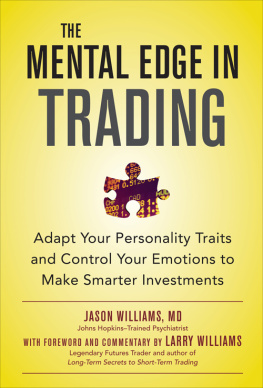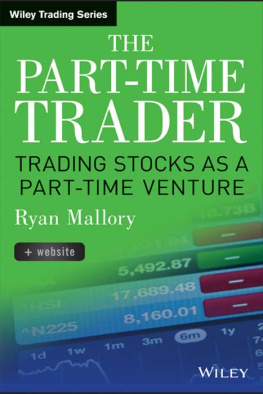
Founded in 1807, John Wiley & Sons is the oldest independent publishing company in the United States. With offices in North America, Europe, Australia and Asia, Wiley is globally committed to developing and marketing print and electronic products and services for our customers' professional and personal knowledge and understanding.
The Wiley Trading series features books by traders who have survived the market's ever changing temperament and have prosperedsome by reinventing systems, others by getting back to basics. Whether a novice trader, professional or somewhere in-between, these books will provide the advice and strategies needed to prosper today and well into the future.
For a list of available titles, visit our website at www.WileyFinance.com .

Cover design: John Wiley & Sons
Copyright 2013 by Thomas N. Bulkowski. All rights reserved.
Published by John Wiley & Sons, Inc., Hoboken, New Jersey.
Published simultaneously in Canada.
No part of this publication may be reproduced, stored in a retrieval system, or transmitted in any form or by any means, electronic, mechanical, photocopying, recording, scanning, or otherwise, except as permitted under Section 107 or 108 of the 1976 United States Copyright Act, without either the prior written permission of the Publisher, or authorization through payment of the appropriate per-copy fee to the Copyright Clearance Center, Inc., 222 Rosewood Drive, Danvers, MA 01923, (978) 750-8400, fax (978) 646-8600, or on the Web at www.copyright.com . Requests to the Publisher for permission should be addressed to the Permissions Department, John Wiley & Sons, Inc., 111 River Street, Hoboken, NJ 07030, (201) 748-6011, fax (201) 748-6008, or online at www.wiley.com/go/permissions .
Limit of Liability/Disclaimer of Warranty: While the publisher and author have used their best efforts in preparing this book, they make no representations or warranties with respect to the accuracy or completeness of the contents of this book and specifically disclaim any implied warranties of merchantability or fitness for a particular purpose. No warranty may be created or extended by sales representatives or written sales materials. The advice and strategies contained herein may not be suitable for your situation. You should consult with a professional where appropriate. Neither the publisher nor author shall be liable for any loss of profit or any other commercial damages, including but not limited to special, incidental, consequential, or other damages.
For general information on our other products and services or for technical support, please contact our Customer Care Department within the United States at (800) 762-2974, outside the United States at (317) 572-3993 or fax (317) 572-4002.
Wiley publishes in a variety of print and electronic formats and by print-on-demand. Some material included with standard print versions of this book may not be included in e-books or in print-on-demand. If this book refers to media such as a CD or DVD that is not included in the version you purchased, you may download this material at http://booksupport.wiley.com . For more information about Wiley products, visit www.wiley.com .
Library of Congress Cataloging-in-Publication Data:
Bulkowski, Thomas N., 1957
Trading basics : evolution of a trader / Thomas N. Bulkowski.
pages cm. (Wiley trading series)
Includes bibliographical references and index.
ISBN 978-1-118-46421-2 (cloth); ISBN 978-1-118-48831-7 (ebk); ISBN 978-1-118-48838-6 (ebk); ISBN 978-1-118-51694-2 (ebk)
1. Portfolio management. 2. Investments. I. Title.
HG4529.5.B85 2013
332.64dc23
2012032671
Preface
Are you like John?
He learned early in life to save his money for a rainy day. Instead of putting it into the bank, he put it into the stock market. He bought Cisco Systems in mid-1999 at 35 and watched the stock soar to 82 in less than a year.
I'm looking for my first 10-bagger, he said, and held onto the stock.
In 2001, when the tech bubble burst, the Cisco balloon popped, too, and it plunged back to 35. He was at breakeven after seeing the stock more than double.
It'll recover, he said. It's a $200 stock. You'll see.
The stock tunneled through 35 then 30, then 20, and bottomed at 15, all in one month. When it hit 10, he sold it for a 70 percent loss.
I should have sold at the top. Buy-and-hold doesn't work. But it did work. Cisco more than doubled, but he held too long.
Next, he tried position trading to better time the exit and chose Eastman Chemical. He bought it in 2003 at 14, just pennies from the bear market bottom, and rode it up to 21 before selling. He made 50 percent in a year. Was he happy?
I sold too soon. The stock continued rising, hitting 30 in 2005. He disliked seeing profits mount after he sold, and wanted to profit from swings in both directions.
He switched to swing trading in 2005 and tried his old favorite: Cisco. The stock bounced from 17 to 20 to 17 to 22 over the next year, but he always bought too late and exited too early. He made money, but not enough.
He took a vacation from his day job and watched Applied Materials wave to him on the computer screen, inviting him to come day trade it. So he did. He made $400 in just 15 minutes. If I can make $400 a day for a year, I'll makehe grabbed his calculator and punched buttons$146,000! No, that's not right. How many trading days are there in a year?
He redid the math and discovered that he could make $100,000 a year by nibbling off just 40 cents a share on 1,000 shares every trading day. Wow. Count me in.
After paying $5,000 for a trading course and more for hardware, software, and data feeds, he took the plunge and started day trading full time.
It took a year to blow through his savings. Another three months took out his emergency fund. He moved back in with his parents while he looked for a real job.
Now, he is saving again and putting it to work in the market. After reading the manuscript for this book, he said, I found a trading style that works for me. I'm a swingera swing trader. And I'm making money, too. He handles not only his own money but his parents and siblings as well, providing them with extra income and building a nest egg for their retirement.
EVOLUTION OF A TRADER
John represents an amalgam of traders, a composite of those searching for a trading style that they can call their own. He suffered through many failed trades before finding a trading style that worked for him. I wrote the Evolution of a Trader series to help people like John.
Evolution of a Trader traces my journey from a buy-and-hold investor to position trader to swing trader to day trader as I searched for styles that worked best when markets evolved. However, these are not autobiographical. Rather, they are an exploration of what has worked, what is supposed to work but does not, and what may work in the future.
This series dissects the four trading styles and provides discoveries, trading tips, setups, and tactics to make each style a profitable endeavor. I have done the research so you do not have to. I show what is needed to make each style work.
CONTENT OVERVIEW
The three books in the Evolution of a Trader series provide numerous tips, trading ideas, and setups based on personal experience and that of others.
Easy to understand tests are used to confirm trading folklore and to illustrate ideas and setups, and yet the books are an entertaining read with an engaging style that appeals to the novice.
Next page
